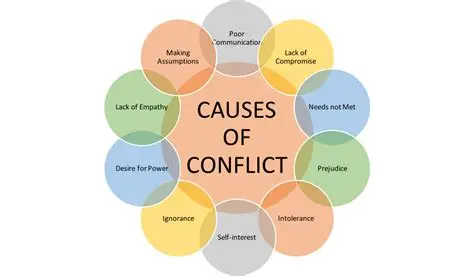What Are the Most Frequent Causes of Conflict?

Conflict in the workplace or any collaborative setting is inevitable. It can stem from a wide range of factors—from poor communication to clashing values. Understanding the root causes of conflict is the first step to preventing, managing, and resolving it effectively.
1. Poor Communication
Misunderstandings often arise when information is unclear, incomplete, or not communicated at all. For example, vague instructions, tone misinterpretation, or a lack of active listening can cause frustration or confusion.
2. Differing Values or Beliefs
When team members have different personal or cultural values, tension can develop. Conflicts may arise around decision-making, priorities, or even work ethics. For instance, someone who values speed over quality may clash with someone who prefers perfectionism.
3. Competing Goals or Priorities
Departments or individuals may have different objectives, which can conflict with each other. A marketing team aiming to launch quickly may bump heads with a development team insisting on more testing time.
4. Unclear Roles and Responsibilities
When people are unsure about their own duties—or others'—there’s room for duplication, dropped tasks, or power struggles. This is especially common in cross-functional teams without clearly defined accountability.
5. Resource Scarcity
Limited access to time, budget, or tools can trigger competition and resentment. Team members may feel they’re being unfairly deprived or that others are getting preferential treatment.
6. Personality Clashes
Not everyone works the same way. Introverts and extroverts, big-picture thinkers and detail-oriented workers, or emotionally expressive and reserved individuals may all have difficulty aligning unless mutual understanding is developed.
7. Stress and Pressure
When workloads are high or deadlines are tight, tempers may flare. High-stress environments make people more likely to react emotionally or defensively.
8. Lack of Accountability
When no one is held responsible for mistakes or poor behavior, resentment builds. A lack of consequences can lead to frustration and long-term tension.
9. Inconsistent Leadership
Leaders who send mixed messages, avoid decision-making, or play favorites can create confusion and conflict within teams.
10. Resistance to Change
Changes in technology, structure, or leadership often create uncertainty. Employees who feel uninformed or insecure may react negatively and clash with those driving the change.
Preventing Conflict
-
Encourage clear communication.
-
Define roles and expectations early.
-
Promote mutual respect and inclusion.
-
Train leaders to model calm, fair behavior.
-
Foster an environment where feedback is welcomed.
Conclusion
While conflict is normal, many of its causes are preventable. By addressing root issues like communication breakdowns or misaligned goals, organizations can build more harmonious and productive teams.
- Arts
- Business
- Computers
- Giochi
- Health
- Home
- Kids and Teens
- Money
- News
- Recreation
- Reference
- Regional
- Science
- Shopping
- Society
- Sports
- Бизнес
- Деньги
- Дом
- Досуг
- Здоровье
- Игры
- Искусство
- Источники информации
- Компьютеры
- Наука
- Новости и СМИ
- Общество
- Покупки
- Спорт
- Страны и регионы
- World


